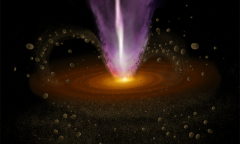Interstellar dust tends to be very, very small. Take your average dust mote floating in a ray of sunlight here on Earth and shrink it down to about 1,000th of its size, then you have a typical grain of space dust. So scientists have long wondered how such small things could ever accumulate into something so large as a pebble, let alone an entire rocky planet.
In fact, models have pointed to something known as the “meter-size barrier” as a hurdle to creating a planet from accreting cosmic dust. Researchers have long considered this barrier because dust amalgamations, as they grow, are at a near constant risk of being smashed into smaller bits or getting pulled into their newly forming star.
But in the constellation of Taurus, just 450 light-years from Earth, swirling disks of protoplanetary material are revealing how this long-standing barrier problem might be solved. A new study, published simply under the title “FAUST” (short for: Fifty AU STudy of the chemistry in the disk-envelope systems of Solar-like protostars) in Astronomy & Astrophysics suggests the answer, my friend, is blowing in the wind.
Using a cluster of high-powered telescopes in Chile called the Atacama Large Millimeter/submillimeter Array, scientists have tracked hefty—1-millimeter-sized—clumps of dust being swept out of the crowded center of this binary star system by cosmic wi





